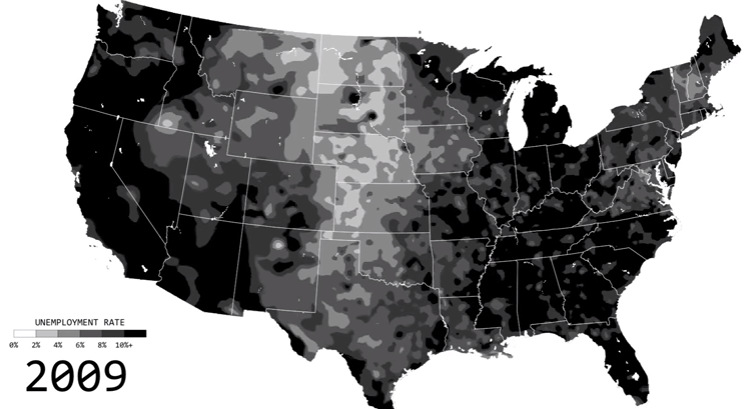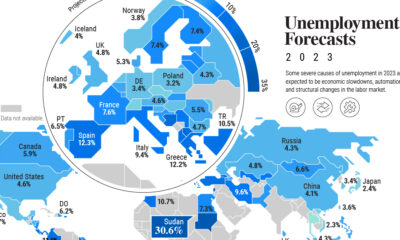Historically, on a national level, an unemployment rate in the 4-6% range is generally considered “good”, while higher rates that fall within the 8-10% range are “bad”. Higher rates are usually only seen during times of recessions or crisis, when people around the country are struggling to find work. But, as you’ll see in today’s animated map, unemployment rates at the regional level are a very different thing. Today’s map, which comes to us from FlowingData, shows the disparity of unemployment rates in the U.S. based on county estimates, and how they have their own ebbs and flows.
The Impact of a Crisis
The most noticeable element of the animation is the “spread” of unemployment as a crisis hits. For reference, here’s the map during 1999 – which is around when income peaked for most Americans.
Now here’s a map of the country during the height of the Financial Crisis in 2009. The “spread” of unemployment catches up to people in even the most economically isolated states.
It goes to show that even people in largely rural counties couldn’t stay isolated from a crisis that originated on Wall Street. While it doesn’t affect them immediately, eventually the “creep” of unemployment hits their counties as well. One interesting exception to note here is North Dakota. With discoveries in the Bakken, and the fracking boom in full flight at the time, the state recorded the lowest rates of unemployment during the crisis. Today, while the oil boom has slowed because of a lower price environment, it’s true that unemployment is still relatively low at 2.8% in the state. on Both figures surpassed analyst expectations by a wide margin, and in January, the unemployment rate hit a 53-year low of 3.4%. With the recent release of February’s numbers, unemployment is now reported at a slightly higher 3.6%. A low unemployment rate is a classic sign of a strong economy. However, as this visualization shows, unemployment often reaches a cyclical low point right before a recession materializes.
Reasons for the Trend
In an interview regarding the January jobs data, U.S. Treasury Secretary Janet Yellen made a bold statement: While there’s nothing wrong with this assessment, the trend we’ve highlighted suggests that Yellen may need to backtrack in the near future. So why do recessions tend to begin after unemployment bottoms out?
The Economic Cycle
The economic cycle refers to the economy’s natural tendency to fluctuate between periods of growth and recession. This can be thought of similarly to the four seasons in a year. An economy expands (spring), reaches a peak (summer), begins to contract (fall), then hits a trough (winter). With this in mind, it’s reasonable to assume that a cyclical low in the unemployment rate (peak employment) is simply a sign that the economy has reached a high point.
Monetary Policy
During periods of low unemployment, employers may have a harder time finding workers. This forces them to offer higher wages, which can contribute to inflation. For context, consider the labor shortage that emerged following the COVID-19 pandemic. We can see that U.S. wage growth (represented by a three-month moving average) has climbed substantially, and has held above 6% since March 2022. The Federal Reserve, whose mandate is to ensure price stability, will take measures to prevent inflation from climbing too far. In practice, this involves raising interest rates, which makes borrowing more expensive and dampens economic activity. Companies are less likely to expand, reducing investment and cutting jobs. Consumers, on the other hand, reduce the amount of large purchases they make. Because of these reactions, some believe that aggressive rate hikes by the Fed can either cause a recession, or make them worse. This is supported by recent research, which found that since 1950, central banks have been unable to slow inflation without a recession occurring shortly after.
Politicians Clash With Economists
The Fed has raised interest rates at an unprecedented pace since March 2022 to combat high inflation. More recently, Fed Chairman Jerome Powell warned that interest rates could be raised even higher than originally expected if inflation continues above target. Senator Elizabeth Warren expressed concern that this would cost Americans their jobs, and ultimately, cause a recession. Powell remains committed to bringing down inflation, but with the recent failures of Silicon Valley Bank and Signature Bank, some analysts believe there could be a pause coming in interest rate hikes. Editor’s note: just after publication of this article, it was confirmed that U.S. interest rates were hiked by 25 basis points (bps) by the Federal Reserve.

















